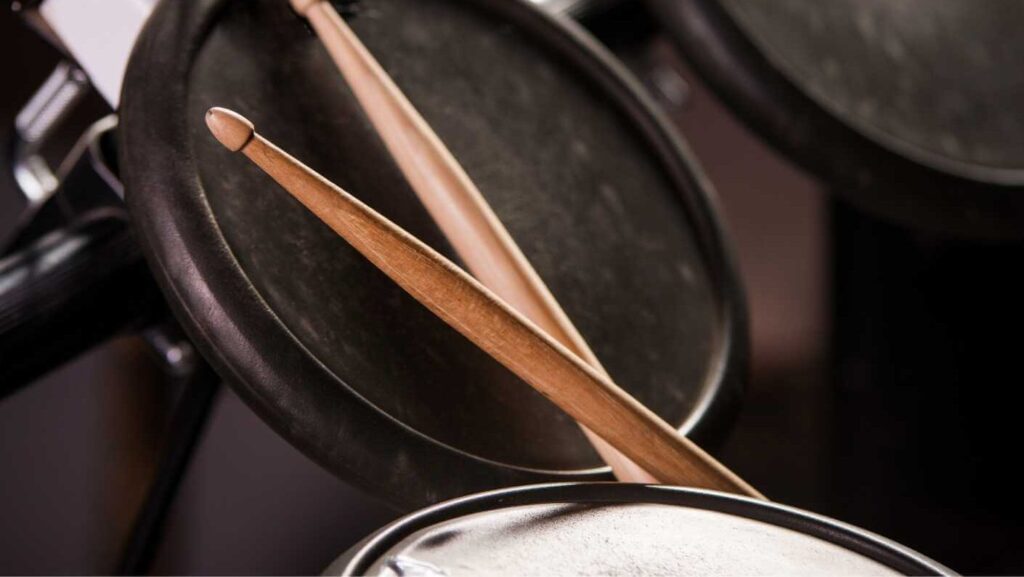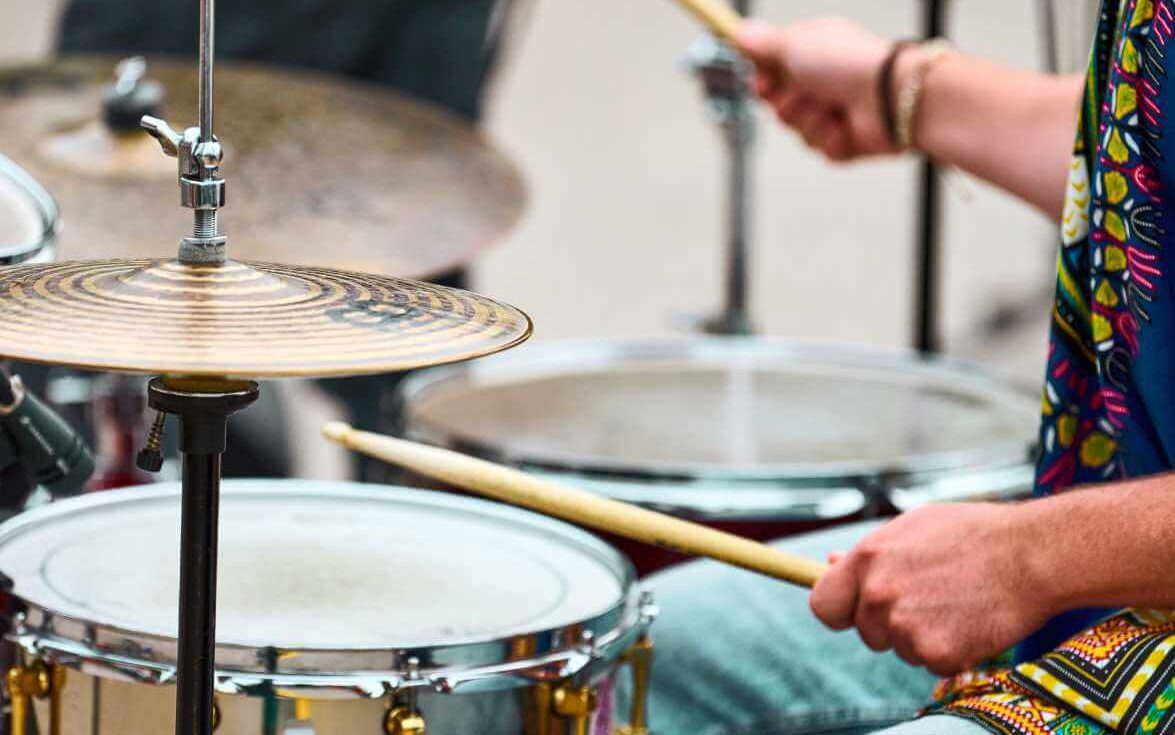Hey there, rhythmic enthusiasts! I’m Ron, your drumming aficionado, and today we’re diving into a fundamental yet often overlooked aspect of drumming: how to hold drumsticks. Whether you’re a budding drummer or looking to refine your technique, this post is your go-to guide. So, let’s roll into the beat of drumming mastery!
The Basics of Grip: Your Foundation for Drumming
Grip is the cornerstone of your drumming technique. It’s not just about holding the sticks; it’s about how you connect with your instrument. A good grip affects the quality of your sound, your ability to play complex rhythms, and even your endurance during long playing sessions. Just like a painter needs the right hold on their brush to create strokes with precision, a drummer needs a proper grip to bring out the best in their playing.

Types of Grips and Their Characteristics
1. The Traditional Grip
Originating from military marching bands, the traditional grip is steeped in history and technique. It’s particularly favored in genres like jazz and orchestral music, where nuanced dynamics are key.
- Left Hand Technique: Hold the stick somewhat like a chopstick, resting between your thumb and the first joint of your index finger. The stick lies across your palm, and your other fingers curl lightly around it. This grip allows for a greater range of motion and subtle wrist movements.
- Right Hand Technique: In traditional grip, the right hand often uses a matched grip (see below). This combination allows for a versatile approach to playing a wide range of musical styles.
2. The Matched Grip
The matched grip is where both hands hold the sticks in the same way, typically in an overhand manner. This grip is intuitive and is widely used across various musical genres, especially in rock, pop, metal, and contemporary music.
- The Fulcrum: In both hands, the fulcrum—the primary point where the stick rotates—is between the thumb and the first one or two fingers. This point is crucial for control and bounce.
- Wrist Alignment: Your wrists should be straight, allowing a natural flow of movement. This alignment helps in preventing strain and injury.

Grip Variations
While the traditional and matched grips are the foundations, there are variations tailored to personal comfort and playing style.
- German Grip: In this variation of the matched grip, the palms face down, and the sticks are held more flatly, allowing for powerful strokes.
- French Grip: Here, the palms face each other, with more emphasis on finger control. This grip is excellent for playing intricate patterns on cymbals or a snare.
- American Grip: A blend of German and French grips, the American grip is versatile, offering a balance between power and finesse.
The Role of Fingers in Grip
Your fingers play a vital role in controlling the sticks. They should be relaxed but ready to make quick, precise movements. For rolls and fast passages, the fingers become particularly important, controlling the rebound and pace of the sticks.
Wrist vs. Arm Movement
Understanding when to use wrist movement and when to engage the entire arm is crucial. For most playing, your wrists do the work, providing control and finesse. Arm movements are used for broader, more powerful strokes, like when hitting crash cymbals or playing forceful backbeats.
Perfecting Your Grip: Techniques and Tips
Refining the Matched Grip
Achieving the Perfect Balance
The essence of the matched grip lies in balance and control. You’re aiming for a grip that’s firm enough to hold the stick securely but relaxed enough to allow it to move freely. The fulcrum, or pivot point, between your thumb and index finger, is key. It should be positioned at a spot on the stick where you can comfortably control the bounce and movement.
Thumb and Finger Positioning
Your thumb should be on the side of the stick, creating a sort of ‘T’ shape with your index finger. The other fingers wrap around the stick, providing support and control. They shouldn’t be squeezing the stick but rather resting on it, ready to assist in control and rebound.
Mastering the Traditional Grip
Left Hand Nuances
In the traditional grip, the left hand plays a unique role. The stick rests in the webbing of your hand, balanced between your thumb and index finger. It’s crucial to find the right spot where the stick feels balanced, allowing for easy control and movement. Your ring and pinky fingers should gently cradle the bottom of the stick, aiding in control without adding unnecessary pressure.
Right Hand Adaptability
While the right hand in traditional grip often mirrors the matched grip, it’s important to adapt it slightly to complement the left. This might mean adjusting the fulcrum point or the way the other fingers interact with the stick to create a balanced, cohesive playing style.
Common Grip Challenges and Solutions
Avoiding Tension
One of the biggest challenges drummers face is avoiding tension in their grip. Regular breaks, stretching, and relaxation exercises can help. If you notice your hands or forearms getting tense while playing, take a moment to shake them out and relax.
Dealing with Sweaty Hands
Sweaty hands can be a nuisance, leading to a slippery grip. Using grip tape, wearing gloves, or using specially designed sticks can help maintain a secure grip.
Fine-Tuning Your Grip for Different Playing Styles
Dynamic Playing
For softer, more dynamic playing, loosen your grip slightly, allowing the stick more freedom to bounce and respond to the drumhead or cymbal. This is particularly useful in genres like jazz or orchestral settings.
Aggressive Playing
In rock or heavy metal, where more power is needed, you might tighten your grip slightly. However, be cautious not to overdo it, as this can lead to fatigue or injury.
Grip Maintenance and Development
Regular Practice
Like any skill, maintaining and improving your grip requires regular practice. Incorporate grip-focused exercises into your practice routine, paying attention to how your grip feels and how it affects your playing.
Seeking Feedback
Don’t hesitate to ask for feedback from more experienced drummers or instructors. They can offer valuable insights into how you might improve your grip and overall technique.

Common Mistakes and How to Avoid Them
Avoiding Over-Gripping and Tension
Recognizing the Signs of Over-Gripping
One of the most common mistakes drummers make is holding the sticks too tightly. This over-gripping often stems from a desire for control but ironically leads to less control, increased fatigue, and a higher risk of injury. Signs of over-gripping include sore wrists, tired arms, and a lack of fluidity in your playing.
Strategies to Reduce Tension
To avoid this, regularly check your grip while playing. Are your shoulders relaxed? Are your wrists flexible? A good practice is to periodically open your hands and let the sticks loosely bounce, ensuring they’re not being gripped too tightly. Additionally, warming up before playing and incorporating stretching into your routine can significantly reduce tension.
Ensuring Proper Stick Balance
Finding the Balance Point
Different drumsticks have varying balance points, and using the wrong part of the stick can lead to poor control and inefficient playing. To find the balance point, balance the stick on your finger. This point is typically where you should place your fulcrum.
Adjusting for Different Stick Types
Be aware that different sticks (e.g., jazz vs. rock sticks) will have different balance points and weights. Adjust your grip accordingly to maintain control and comfort.
Neglecting Finger Control
The Role of Fingers in Drumming
A mistake often overlooked is neglecting the role of fingers in controlling the stick, especially in the matched grip. Your fingers are crucial for fine control, particularly in playing at lower volumes or executing intricate rhythms.
Exercises to Improve Finger Control
Practice exercises that specifically focus on finger control, such as playing at low volumes or working on rudiments that require subtle stick movements. This can greatly enhance your overall control and precision.
Inconsistent Grip Between Hands
Maintaining Symmetry in Matched Grip
Inconsistency between how each hand holds the stick is a common issue, especially in beginners. This can lead to uneven sounds and rhythms. Regularly check that both hands are using a similar grip, adjusting as necessary to ensure symmetry.
Harmonizing Grips in Traditional Grip
For those using traditional grip, it’s important to ensure your right hand (in matched grip) and your left hand (in traditional grip) work in harmony. This might mean making slight adjustments to how each hand approaches the drum to create a unified sound.
Not Adapting Grip for Different Drums and Cymbals
Adapting to Various Instruments
Each component of a drum kit requires a slightly different approach. For example, playing on a hi-hat might require a looser grip for more bounce, while a floor tom might need a firmer grip for more power.
Practice on Different Surfaces
To become adaptable, practice on different parts of the drum kit, focusing on how your grip affects the sound and feel of each drum or cymbal.

Practice Makes Perfect: Exercises and Drills
Basic Stroke Practice
Start with single stroke rolls (alternating hits with each stick) at a slow tempo. Focus on producing a consistent sound from each hand while maintaining a relaxed grip. Gradually increase the speed while ensuring your grip doesn’t tighten as you play faster.
Rebound Control
Practice allowing the stick to rebound off the drumhead or practice pad naturally. Strike and let the stick bounce back without any additional force from your hand. This exercise helps in developing a feel for the stick’s natural movement and improves your dynamic control.
Advanced Techniques for Seasoned Drummers
Rudiment Practice
Incorporate drum rudiments into your routine. Start with single, double, and triple paradiddles, accentuating different notes to challenge your grip and stick control. Rudiments are the building blocks of drumming and offer endless possibilities to refine your technique.
Dynamic Range Exercises
Practice playing at different dynamics, from pianissimo (very soft) to fortissimo (very loud). This helps in developing control over your grip and stroke, regardless of the volume. Use a metronome to maintain consistent timing.
Endurance and Speed Building
Long Play-Alongs
Choose a few of your favorite songs and play along from start to finish. This not only builds endurance but also helps you apply your grip techniques in a musical context. It’s a fun way to see how your grip holds up over longer periods.
Speed Exercises
Set a metronome to a comfortable speed and play single strokes. Gradually increase the tempo while ensuring your grip remains relaxed. This builds both speed and endurance, crucial for faster and more intense playing situations.
Finger Control Drills
Finger Dexterity Exercises
Isolate your fingers by playing strokes using only your fingers, without wrist movement. This can be challenging at first but greatly improves your fine control and speed, especially for playing on cymbals and hi-hats.
Push-Pull Technique
This advanced technique involves pushing the stick down with your fingers and then pulling it back up, creating a fluid, bouncing motion. It’s great for fast tempos and intricate rhythms.
Applying Techniques in Musical Contexts
Groove Practice
Incorporate your grip and stick control techniques into various drum grooves. Pay attention to how different grips affect the feel and sound of the groove.
Soloing and Fills
Practice drum solos and fills, focusing on transitioning smoothly between different grips and techniques. This helps in applying your technical skills in a more creative and musical way.

Embrace the Beat with Confidence
Mastering the art of holding drumsticks is a journey that can profoundly impact your drumming. Remember, there’s no one-size-fits-all approach. Experiment with different grips, sticks, and techniques to find what works best for you. Most importantly, have fun and let your passion for rhythm shine through your newfound mastery of the sticks. Keep drumming, and let the beat guide you!
And that’s a wrap on our drumstick-holding masterclass! I hope this post has been both informative and inspiring for all you drum enthusiasts out there. Remember, practice is key, so grab those sticks and make some noise! Until next time, keep the rhythm alive!




